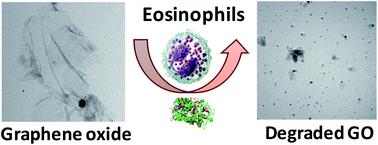当前位置:
X-MOL 学术
›
Faraday Discuss.
›
论文详情
Our official English website, www.x-mol.net, welcomes your
feedback! (Note: you will need to create a separate account there.)
Biodegradation of graphene materials catalyzed by human eosinophil peroxidase
Faraday Discussions ( IF 3.3 ) Pub Date : 2020-1-31 , DOI: 10.1039/c9fd00094a Rajendra Kurapati 1 , Cristina Martìn , Vincenzo Palermo , Yuta Nishina , Alberto Bianco
Faraday Discussions ( IF 3.3 ) Pub Date : 2020-1-31 , DOI: 10.1039/c9fd00094a Rajendra Kurapati 1 , Cristina Martìn , Vincenzo Palermo , Yuta Nishina , Alberto Bianco
Affiliation

|
Understanding the biodegradability of graphene materials by the action of oxidative enzymes secreted by immune cells is essential for developing applicable biomedical products based on these materials. Herein, we demonstrate the biodegradation of graphene oxide (GO) by recombinant eosinophil peroxidase (EPO) enzyme extracted from human eosinophils in the presence of a low concentration of hydrogen peroxide and NaBr. We compared the degradation capability of the enzyme on three different GO samples containing different degrees of oxygen functional groups on their graphenic lattices. EPO succeeded in degrading the three tested GO samples within 90 h treatment. Raman spectroscopy and transmission electron microscopy analyses provided clear-cut evidence for the biodegradation of GO by EPO catalysis. Our results provide more insight into a better understanding of the biodegradation of graphene materials, helping the design of future biomedical products based on these carbon nanomaterials.
中文翻译:

人嗜酸性粒细胞过氧化物酶催化石墨烯材料的生物降解
通过免疫细胞分泌的氧化酶的作用了解石墨烯材料的生物降解性对于开发基于这些材料的适用生物医学产品至关重要。在此,我们展示了在低浓度过氧化氢和溴化钠存在下,从人嗜酸性粒细胞中提取的重组嗜酸性粒细胞过氧化物酶 (EPO) 对氧化石墨烯 (GO) 的生物降解作用。我们比较了酶在三种不同的 GO 样品上的降解能力,这些样品的石墨晶格上含有不同程度的氧官能团。EPO 在 90 小时处理内成功降解了三个测试的 GO 样品。拉曼光谱和透射电子显微镜分析为 EPO 催化对 GO 的生物降解提供了明确的证据。
更新日期:2020-01-31
中文翻译:

人嗜酸性粒细胞过氧化物酶催化石墨烯材料的生物降解
通过免疫细胞分泌的氧化酶的作用了解石墨烯材料的生物降解性对于开发基于这些材料的适用生物医学产品至关重要。在此,我们展示了在低浓度过氧化氢和溴化钠存在下,从人嗜酸性粒细胞中提取的重组嗜酸性粒细胞过氧化物酶 (EPO) 对氧化石墨烯 (GO) 的生物降解作用。我们比较了酶在三种不同的 GO 样品上的降解能力,这些样品的石墨晶格上含有不同程度的氧官能团。EPO 在 90 小时处理内成功降解了三个测试的 GO 样品。拉曼光谱和透射电子显微镜分析为 EPO 催化对 GO 的生物降解提供了明确的证据。











































 京公网安备 11010802027423号
京公网安备 11010802027423号